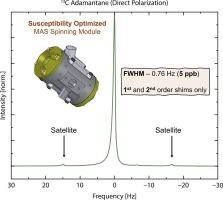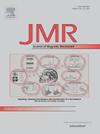Magnetic Susceptibility Modeling of Magic-Angle Spinning Modules for Part Per Billion Scale Field Homogeneity
Abstract
Magic-angle spinning (MAS) solid-state NMR methods are crucial in many areas of biology and materials science. Conventional probe designs have often been specified with 0.1 part per million (ppm) or 100 part per billion (ppb) magnetic field resolution, which is a limitation for many modern scientific applications. Here we describe a novel 5-mm MAS module design that significantly improves the linewidth and line shape for solid samples by an improved understanding of the magnetic susceptibility of probe materials and geometrical symmetry considerations, optimized to minimize the overall perturbation to the applied magnetic field (B0). The improved spinning module requires only first and second order shimming adjustments to achieve a sub-Hz resolution of 13C resonances of adamantane at 150 MHz Larmor frequency (14.1 Tesla magnetic field). Minimal use of third and higher order shims improves experimental reproducibility upon sample changes and the exact placement within the magnet. Furthermore, the shimming procedure is faster, and the required gradients smaller, thus minimizing thermal drift of the room temperature (RT) shims. We demonstrate these results with direct polarization (Bloch decay) and cross polarization experiments on adamantane over a range of sample geometries and with multiple superconducting magnet systems. For a direct polarization experiment utilizing the entire active sample volume of a 5-mm rotor (90 µl), we achieved full width at half maximum (FWHM) of 0.76 Hz (5 ppb) and baseline resolved the 13C satellite peaks for adamantane as a consequent of the 7.31 Hz (59 ppb) width at 2% intensity. We expect these approaches to be increasingly pivotal for high-resolution solid-state NMR spectroscopy at and above 1 GHz 1H frequencies.


 求助内容:
求助内容: 应助结果提醒方式:
应助结果提醒方式:


